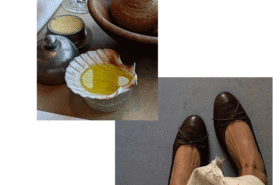
If there’s one thing that gets me through the winter (and tbh, early spring and fall) its cozy materials – notable cashmere.
As I’ve gotten more acquainted with it over the years though, I’ve come to realize that not all cashmere is created equal. Now I wouldn’t say that I’m a cashmere expert, but I know enough to be dangerous. Below are four things I like to consider when buying cashmere – grade, ply, gauge and weight – as well as a few tips for buying cashmere in store.
First off, always check the label. What many brands call “cashmere” is really just a blend between cashmere and wool. This can be much cheaper, but drastically inferior in terms of quality and feel, and more subject to pilling. From there, you’ll want to consider the quality of the cashmere itself aka the grade. Just because the label says 100% cashmere doesn’t mean that it’s good cashmere.
Grade
The grade is determined by the thickness of the cashmere fiber itself. There are three cashmere quality grades—A through C. Grade A is the creme de la creme of cashmere at 14 microns. It’s the most expensive of the three grades because its fibers are the thinest, longest and most durable. Grade B is the middle of the pack at around 19 microns. Grade C is the lowest quality cashmere at 30 microns. Grade C cashmere is is also the cheapest. Grade will often be the sole indicator of the quality of cashmere where as ply, gauge and weight will provide more details on how warm and durable a cashmere piece.
If the quality is not indicated, an easy way to tell is to run your hand over the cashmere. If little wads of fibers start to form, it means there are shorter fibers within the fabric which is indicative of a lower quality. Additionally, if it feels “slippery” or “slick” that is usually a sign that the cashmere has been over processed and/or coated with something to make it seam like it is a better quality.
Ply
Ply is the number of cashmere threads twisted together to make cashmere yarn. For example, two threads twisted is referred to as 2-ply, three threads – 3-ply and so on and so forth. Ply will help you determine how warm and durable an item will be. A higher ply will be more durable and warmer (more cashmere) where as a lower ply will be the opposite. Look for items with 2-ply or higher as 1-ply is less durable and is more prone to holes.
Gauge
Gauge is the measure of how tightly an item is knitted. The higher the gauge number, the tighter the knit and the more cashmere yarn is used. For example, with 12-gauge, there are 12 stitches or rows of yarn in one inch of knitted cashmere, so the cashmere is relatively dense. With 7-gauge or even something lower, there are 7 stitches or rows per inch, so the cashmere has a more open and airy look with a more relaxed drape and is more lightweight than an item knitted in 12 gauge. This can create a smoother, more refined appearance and give the fabric more structure and stability.
Weight
Weight is another indicator of how much cashmere is in an item and how warm it will be. A heavier weight cashmere sweater, with a higher ply and tighter gauge will be warmer than something with a lower ply and looser gauge.
Now, sometimes you can find this information on an items product page. For example, brands like Lisa Yang and Naked Cashmere list both the gauge and weight on their product page where as Quince, Naadam and Everlane indicate the grade of cashmere they use. However most of the time, brands don’t provide anything other an 100% cashmere in the product details.
Also, one quick note on pilling as it’s definitely paint point with cashmere! All cashmere pills with friction over time, but only the lowest quality will pill immediately. The shorter the fibers of a fabric are, the more easily they pill. With respect to cashmere, it does pill, but it depends on the quality of the cashmere. A finer, tighter cashmere (or wool, and probably cotton too) will pill less than the lower grades of cashmere
xx
S



